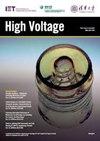Preparation Method and Performance Study of Nanocellulose/Epoxy Resin Composite Materials Modified by Multiple Approaches
IF 4.9
2区 工程技术
Q1 ENGINEERING, ELECTRICAL & ELECTRONIC
引用次数: 0
Abstract
Nanocomposites are pivotal for enhancing epoxy resin performance, but traditional inorganic nanofillers' poor compatibility and nonrecyclability pose environmental concerns. This study utilises recyclable organic cellulose nanocrystals (CNC) to explore their modification impact on epoxy composite properties. Through infrared spectroscopy and X-ray photoelectron spectroscopy (XPS), the degree of modification for CNC and its derivatives—KH560-modified CNC (KH560-CNC) and methyl methacrylate-modified CNC (MMA-CNC)—was assessed. Scanning electron microscope (SEM) performance characterisation of modified CNC/epoxy composites showed that higher CNC modification levels significantly improve the toughness of the composites. Regarding thermal conductivity, modified CNCs affected the epoxy composites differently; KH560-CNC/EP exhibited the best thermal conductivity at low filler concentrations, whereas MMA-CNC/EP showed higher thermal conductivity at high concentrations. Additionally, nanocellulose's varying degrees of modification differently impacted the composites' moisture absorption and dielectric properties. The higher the CNC modification level, the stronger its moisture absorption capability, with minimal effect on dielectric loss. This paper provides experimental evidence for CNC/epoxy composite applications, offering practical guidance for future design and manufacturing of epoxy resin composites.多途径改性纳米纤维素/环氧树脂复合材料的制备方法及性能研究
纳米复合材料是提高环氧树脂性能的关键,但传统的无机纳米填料相容性差,不可回收利用,造成了环境问题。本研究利用可回收有机纤维素纳米晶(CNC)来探索其改性对环氧复合材料性能的影响。通过红外光谱和x射线光电子能谱(XPS)对CNC及其衍生物kh560改性CNC (KH560-CNC)和甲基丙烯酸甲酯改性CNC (MMA-CNC)的改性程度进行了评价。改性CNC/环氧复合材料的扫描电镜(SEM)性能表征表明,较高的CNC改性水平显著提高了复合材料的韧性。在导热性能方面,改性cnc对环氧复合材料的影响不同;KH560-CNC/EP在填料浓度较低时导热性能最好,而MMA-CNC/EP在填料浓度较高时导热性能较好。此外,纳米纤维素的不同改性程度对复合材料的吸湿性能和介电性能有不同的影响。CNC改性水平越高,吸湿能力越强,对介质损耗的影响最小。本文为CNC/环氧复合材料的应用提供了实验依据,为今后环氧树脂复合材料的设计和制造提供了实践指导。
本文章由计算机程序翻译,如有差异,请以英文原文为准。
求助全文
约1分钟内获得全文
求助全文
来源期刊

High Voltage
Energy-Energy Engineering and Power Technology
CiteScore
9.60
自引率
27.30%
发文量
97
审稿时长
21 weeks
期刊介绍:
High Voltage aims to attract original research papers and review articles. The scope covers high-voltage power engineering and high voltage applications, including experimental, computational (including simulation and modelling) and theoretical studies, which include:
Electrical Insulation
● Outdoor, indoor, solid, liquid and gas insulation
● Transient voltages and overvoltage protection
● Nano-dielectrics and new insulation materials
● Condition monitoring and maintenance
Discharge and plasmas, pulsed power
● Electrical discharge, plasma generation and applications
● Interactions of plasma with surfaces
● Pulsed power science and technology
High-field effects
● Computation, measurements of Intensive Electromagnetic Field
● Electromagnetic compatibility
● Biomedical effects
● Environmental effects and protection
High Voltage Engineering
● Design problems, testing and measuring techniques
● Equipment development and asset management
● Smart Grid, live line working
● AC/DC power electronics
● UHV power transmission
Special Issues. Call for papers:
Interface Charging Phenomena for Dielectric Materials - https://digital-library.theiet.org/files/HVE_CFP_ICP.pdf
Emerging Materials For High Voltage Applications - https://digital-library.theiet.org/files/HVE_CFP_EMHVA.pdf
 求助内容:
求助内容: 应助结果提醒方式:
应助结果提醒方式:


